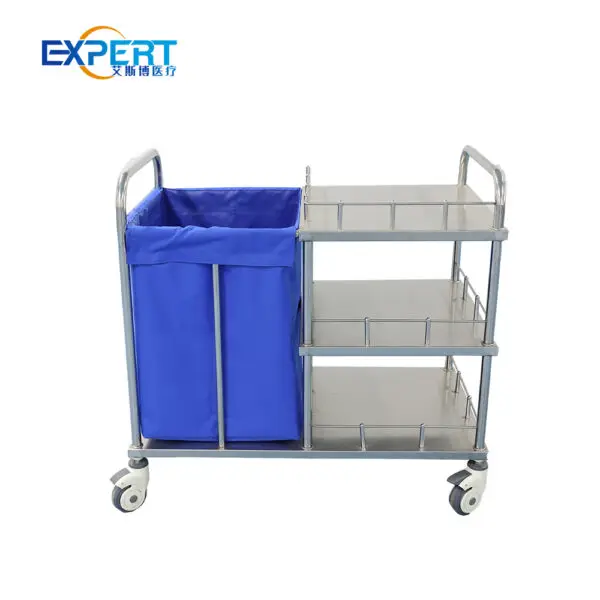Dirección
304 North Cardinal St.
Dorchester Center, MA 02124
Horas laborales
Lunes a viernes: 7:00 a. M. - 7:00 p. M.
Fin de semana: 10 a. M. - 5 p. M.
¡Bienvenido a mi blog!
Antes de profundizar en el contenido, me encantaría que te unas a mí en mis plataformas de redes sociales, donde comparto más información, interactúo con la comunidad y publico actualizaciones. Puedes conectarte conmigo de la siguiente manera:
Facebook:https://www.facebook.com/profile.php?id=100071234835011
LinkedIn:https://www.linkedin.com/company/74943205/admin/dashboard/
YouTube:www.youtube.com/@shandongexpertmedicalequip4695
TikTok:www.tiktok.com/@expertmedical
Ahora, comencemos nuestro viaje juntos. Espero que el contenido que se incluye aquí te resulte interesante, interesante y valioso.


En el dinámico entorno de la atención médica, la eficiencia y la organización son fundamentales. Los profesionales médicos dependen en gran medida de equipos esenciales para brindar la mejor atención al paciente, y entre estos, el carro de atención hospitalaria desempeña un papel fundamental. Ya sea que se utilice para la distribución de medicamentos, la respuesta a emergencias o procedimientos médicos rutinarios, un carro de alta calidad... carro de atención hospitalaria Puede mejorar significativamente el flujo de trabajo y la seguridad del paciente. Sin embargo, muchos centros de salud siguen utilizando carros obsoletos, sin ser conscientes de los riesgos que suponen. Si su personal médico experimenta ineficiencia, problemas de seguridad o fallos de funcionamiento frecuentes, quizá sea el momento de considerar una actualización. Este artículo explora cinco señales de advertencia que indican que su carro de atención hospitalaria necesita ser reemplazado y ofrece orientación para seleccionar una mejor alternativa.
Una de las señales más obvias de que tu carro de atención hospitalaria La razón por la que ya no satisface sus necesidades es su frecuente necesidad de mantenimiento. Un carro que se descompone constantemente interrumpe el flujo de trabajo y retrasa la atención esencial al paciente. Las averías pueden ir desde ruedas defectuosas y cerraduras rotas hasta fallos electrónicos en los modelos más avanzados, lo que hace que las operaciones diarias sean más frustrantes e ineficientes.
Si tu carro de atención hospitalaria Si requiere reparaciones casi mensualmente, quizás sea momento de considerar una actualización. Invertir en un carro duradero y de alto rendimiento no solo mejorará la eficiencia, sino que también optimizará el flujo de trabajo del personal y la seguridad del paciente.

Los entornos hospitalarios requieren carros que se puedan mover fácilmente por diferentes superficies. Si su carro es difícil de empujar, tiene ruedas rígidas o no se mueve con suavidad, puede convertirse en una carga en lugar de una herramienta útil.
Un moderno carro de atención hospitalaria Con ruedas de alta calidad, ruedas de deslizamiento suave y asas ergonómicas, la movilidad se mejora significativamente. Cambiar a un modelo bien diseñado garantiza una navegación fluida por pasillos, ascensores y habitaciones de pacientes, permitiendo al personal médico realizar sus tareas eficientemente sin obstáculos innecesarios.
Un eficiente carro de atención hospitalaria Debe ofrecer un amplio espacio de almacenamiento para suministros médicos esenciales, garantizando que todo esté al alcance de la mano. Si su carrito actual tiene compartimentos insuficientes, cajones desordenados o no cuenta con un sistema de almacenamiento seguro para medicamentos, quizás sea hora de renovarlo.
| Característica | Carrito obsoleto | Carrito moderno |
|---|---|---|
| Capacidad de almacenamiento | Compartimentos limitados, cajones abarrotados | Secciones espaciosas y bien organizadas |
| Mecanismo de bloqueo | Cerraduras básicas o anticuadas | Seguridad avanzada con entrada digital o sin llave |
| Personalización | Disposición fija, difícil de modificar. | Diseño modular para configuraciones personalizables |
| Accesibilidad | Suministros de difícil acceso, distribución ineficiente | Diseño ergonómico de fácil acceso para una recuperación rápida. |
Los modelos más nuevos ofrecen soluciones de almacenamiento mejoradas, que incluyen cajones modulares, sistemas de bloqueo seguros y compartimentos de fácil acceso que mejoran la organización y el flujo de trabajo.

La seguridad es un aspecto crucial de cualquier carro de atención hospitalaria, especialmente al manipular medicamentos e instrumental médico sensible. Si su carrito no cuenta con medidas de seguridad avanzadas, como cerraduras electrónicas o sistemas de control de acceso, podría poner en riesgo a los pacientes y al personal.
Actualizar a un carro de atención hospitalaria Con funciones de seguridad modernas, como acceso biométrico o tecnología RFID, podemos garantizar el cumplimiento de los estándares de la industria y proteger valiosos recursos médicos.
A medida que la tecnología sanitaria avanza, los equipos hospitalarios deben mantenerse al día. Si su carro de atención hospitalaria Si carece de características como fuentes de energía integradas, pantallas digitales o compatibilidad con sistemas de registros médicos electrónicos (EMR), es posible que esté disminuyendo la eficiencia.
Moderno carros de atención hospitalaria Están diseñados para integrarse perfectamente con la tecnología médica, lo que permite a los proveedores de atención médica trabajar de manera más inteligente, no más difícil.
A carro de atención hospitalaria Es una herramienta esencial en cualquier centro médico, pero usar un modelo obsoleto puede generar ineficiencias, riesgos de seguridad y mayores costos. Si su carro falla con frecuencia, no cuenta con el almacenamiento adecuado, es difícil de maniobrar, presenta poca seguridad o no se integra bien con la tecnología moderna, es hora de actualizarlo. Invertir en un carro de atención hospitalaria de alta calidad y tecnología avanzada puede mejorar el flujo de trabajo, aumentar la seguridad del paciente y optimizar las operaciones generales de atención médica. Al reconocer estas señales de advertencia a tiempo, puede tomar decisiones informadas para mejorar la eficiencia y la eficacia de su centro médico.
Los carros de atención hospitalaria suelen durar entre 5 y 10 años, pero averías frecuentes, funciones obsoletas o cambios en los requisitos del hospital pueden obligar a reemplazarlos antes. Las evaluaciones periódicas ayudan a determinar cuándo es necesario actualizarlos.
Las características clave a considerar incluyen movilidad suave, amplio espacio de almacenamiento, sistemas de bloqueo seguros, diseño ergonómico e integración tecnológica como seguimiento digital de medicamentos y sistemas de seguridad electrónicos.
Sí, los carros electrónicos con fuentes de energía integradas, seguimiento digital y mecanismos de bloqueo inteligentes mejoran la eficiencia, mejoran la seguridad y reducen los errores de medicación, lo que los convierte en una inversión valiosa para los centros de atención médica.
Muchos carros de atención hospitalaria modernos ofrecen diseños modulares que permiten la personalización para diferentes aplicaciones médicas, lo que hace posible que las instalaciones adapten los carros en función de las necesidades departamentales, la eficiencia del flujo de trabajo y los requisitos de almacenamiento.
Para maximizar la vida útil de un carro de atención hospitalaria, limpie periódicamente las superficies del carro, revise las ruedas y las cerraduras para detectar desgaste, actualice las características de seguridad según sea necesario y asegúrese de organizar y almacenar adecuadamente los suministros médicos.
Avisos
